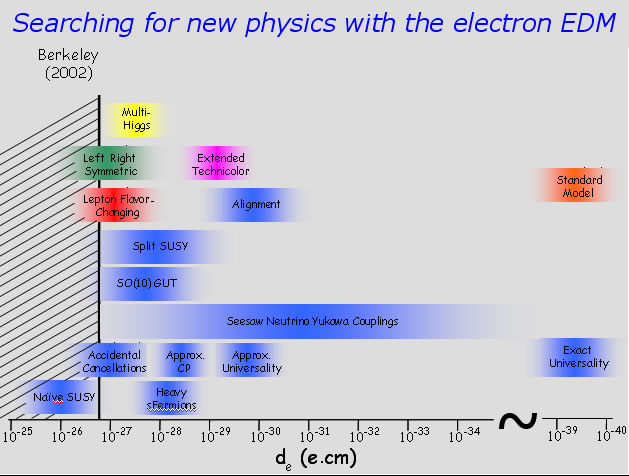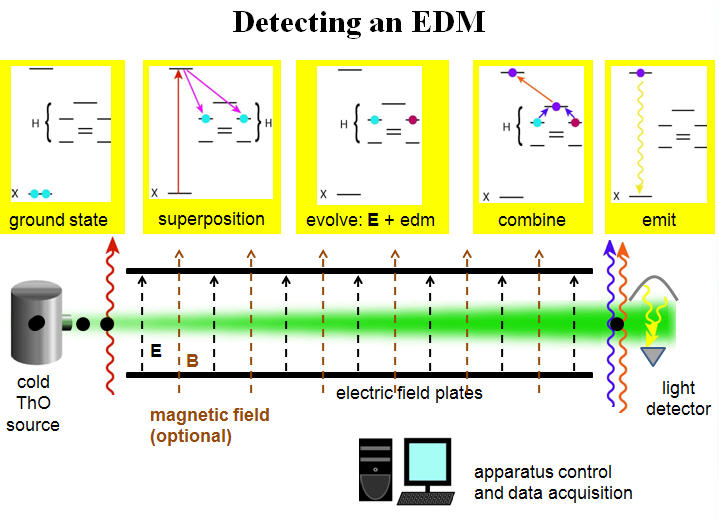The electron certainly has an magnetic dipole moment; the Gabrielse group has measured the electron magnetic moment much more accurately than has any other research group - to an accuracy of 3 parts in 1013.
Does the electron also have an electric dipole moment? No electron electric dipole moment (EDM) has been detected so far. And, the standard model of particle physics predicts that the electron's electric dipole moment is so small that it probably will not be possible to ever detect it in the foreseeable future. However, most all of the proposed extensions to the standard model of particle physics predict that the electron would have an EDM that could be detected if measurement uncertainties can be reduced by an order or magnitude or two below what was reported in Berkeley in 2002 (figure below). Our objective is to do this, and perhaps more.

The desirability of a timely EDM measurement is increased by the expected discovery of new particles as the Large Hadron Collide (LHC) begins to probe what is believed to be the Higgs energy scale. EDM measurements are the most promising probe of whether new particles are related to T violation. We hope to provide one of the few constraints on extensions to the Standard Model in the unlikely event that no particles and physics beyond the Standard Model are observed at the LHC, and to eventually probe energies beyond the reach of the LHC and foreseeable future accelerators.
 |
ACME, short for "Advanced Cold Molecule Electric Dipole Moment Search", is a collaboration of the Gabrielse research group with the research groups of Doyle (of Harvard) and DeMille (of Yale). In pursuit of a timely measurement, ACME combines the experience and expertise of the research group that developed many molecular EDM techniques, the group that developed the crucial cryogenic molecule source, and the group that made the highest accuracy measurements of the electron's magnetic moment and other precision measurements. ACME is larger than typical for past EDM searches done at low energy -- all of which were development projects without the resources needed to achieve a first result in less than a decade or two. The ACME electron EDM search will move from development to measurement. |
The ACME ApproachA better molecule: The ThO molecule that we have identified provides in one species all the advantages identified by past molecular EDM studies, with the added benefit of a higher internal electric field. A better molecular source: The prototype ThO molecular beam source that ACME is developing, using laser ablation and cryogenic buffer gas cooling, already demonstrates the possibility of a usable flux of molecules that is a thousand times that of previous experiments. Big consequences whatever the ACME result: The initial ACME goal is to measure the electron EDM on a five year scale with a sensitivity that greatly exceeds the current limit. The lack of an electron EDM at attainable precisions would eliminate the most studied and motivated extensions to the Standard Model. The discovery of an electron EDM would be one of the great breakthroughs in physics, signifying the long anticipated breakdown of the Standard Model of particle physics, and heralding a new understanding of the imbalance between antimatter and matter in the universe. |
 |
So far the Gabrielse group is focusing upon building up and stabilizing the many laser systems that are needed to measure the flux of the ThO beam, to excite the states that we need, and for detecting the energy shift that would signal the presence of an EDM. Yulia Gurevich and Ben Spaun are doing this as part of their PhD thesis work. We are also developing the data acquisition system that will allow ACME to automate its long term data taking.
© 2015 - Last Updated: 08/30/2018 - Disclaimer